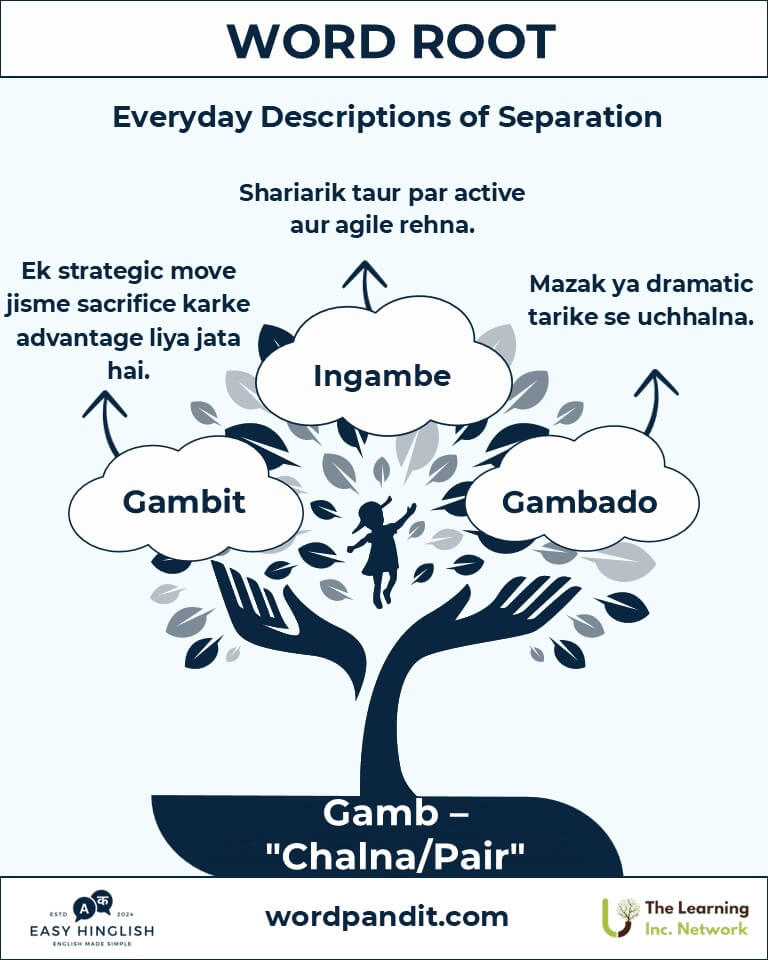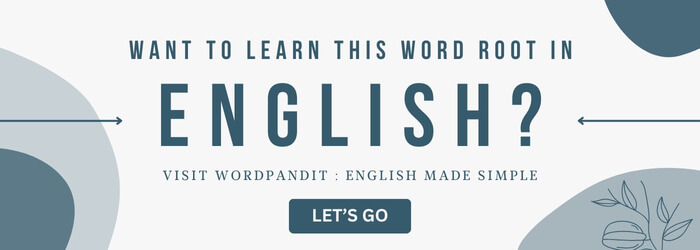Gamb: The Leg Root of Movement and Strategy in Language
(Gamb: चलना और योजना का मूल)

Table of Contents
- Introduction: The Essence of "Gamb"
- Etymology and Historical Journey
- Mnemonic: Unlocking the Power of "Gamb"
- Common "Gamb"-Related Terms
- "Gamb" Through Time
- "Gamb" in Specialized Fields
- Illustrative Story: "Gamb" in Action
- Cultural Significance of the "Gamb" Root
- The "Gamb" Family Tree
- FAQs About the "Gamb" Word Root
- Test Your Knowledge: "Gamb" Mastery Quiz
- Conclusion: The Living Legacy of "Gamb"
Introduction: The Essence of "Gamb"
(परिचय: गम्ब की मुख्य बात)
The root "Gamb" signifies movement, strategy, and action. Found in words like "gambit" and "gamble," it has played a key role in shaping concepts of risk-taking, strategy, and leg-based motion throughout history.

Etymology and Historical Journey
(गम्ब का इतिहास और उत्पत्ति)
The word "Gamb" comes from the Italian "gamba," meaning "leg." This root later influenced French and English, appearing in terms related to stepping, jumping, and strategic movement in games and life.
Mnemonic: Unlocking the Power of "Gamb"
(Mnemonic के ज़रिए गम्ब को याद रखें)
Picture a chess player moving a pawn forward, sacrificing it for a greater gain. This represents the essence of "gamb"—a calculated move that involves risk but has the potential for a big reward.
Mnemonic Device:
"Gamb steps ahead, taking risks to gain the upper hand!"
Common "Gamb"-Related Terms
(गम्ब से जुड़े आम शब्द)
- Gambit: A strategic move in chess or negotiation.
Example: "She played an early gambit to take control of the board." - Gamble: To take a risk with potential rewards.
Example: "Investing in startups is always a gamble." - Gambol: To leap or jump playfully.
Example: "The children gamboled in the meadow." - Gambrel: A type of roof structure with two slopes.
Example: "The old barn had a classic gambrel roof."
"Gamb" Through Time
(गम्ब का सफर समय के साथ)
- Medieval Europe: "Gambit" was used in chess and military strategies.
- 18th Century: "Gamble" became popular in gaming culture.
- Modern Usage: "Gambol" is used for playful movements in literature.
"Gamb" in Specialized Fields
(गम्ब का विशेष क्षेत्रों में महत्व)
- Chess: "Gambit" refers to sacrificing a piece for strategic advantage.
- Finance: "Gamble" describes high-risk investments.
- Architecture: "Gambrel" roofs are common in barn-style houses.
Illustrative Story: "Gamb" in Action
(गम्ब की कहानी)
In a high-stakes chess tournament, Rohan decided to play a bold gambit early in the game. He sacrificed his knight to gain a strategic advantage over his opponent. The crowd gasped, unsure if it was a risky gamble or a masterstroke. As the game progressed, his plan unfolded perfectly, and he emerged victorious, proving that sometimes, taking a calculated step forward is the key to success.
Cultural Significance of the "Gamb" Root
(संस्कृति में गम्ब का महत्व)
The root "Gamb" has had a lasting impact across cultures. From medieval battle strategies to modern financial investments, it represents the fine balance between risk and reward. In literature, gambits symbolize clever maneuvers, while in sports, they signify well-planned tactics.

The "Gamb" Family Tree
(गम्ब परिवार के शब्द)
- Leg-Based Terms:
- Gambol: To leap or jump energetically.
- Gambado: A large leap or bound.
- Strategy and Risk Terms:
- Gambit: A strategic move in games and negotiations.
- Gamble: To take a risk for potential gain.
- Architecture:
- Gambrel: A type of roof structure.

FAQs About the "Gamb" Word Root
Q: What does "Gamb" mean?
A: "Gamb" means "leg." It comes from the Italian "gamba" and Latin "gamba," originally describing an animal’s limb or shank.
Q: What does "Gambit" mean in chess?
A: "Gambit" refers to a strategic opening move in which a player sacrifices a pawn or piece to gain tactical or positional advantage.
Q: What is "Ingambe," and is it commonly used in English?
A: "Ingambe" is of Italian origin and is rarely used in English. It means lively or agile, describing physical readiness and vitality.
Q: What is a Gambrel roof?
A: A Gambrel roof is a type of roof with two slopes on each side—one steep and one gentle. It is named for its curved shape, resembling an animal's hind leg.
Q: What does "Gambado" mean?
A: "Gambado" refers to a playful or exaggerated leap. It is used in theater and literature to depict joy and excitement.
Test Your Knowledge: "Gamb" Mastery Quiz
1. What does the root "Gamb" mean?
2. What is a "Gambit" in chess?
3. What does "Ingambe" describe?
4. In which field is the term "Gambrel" used?
5. What does "Gambado" mean?
Conclusion: The Living Legacy of "Gamb"
(गम्ब की जीवंत विरासत)
The "Gamb" root remains alive in modern language, connecting movement, strategy, and calculated risks. Whether in chess, business, or architecture, it represents the importance of taking bold steps forward while considering potential outcomes.








